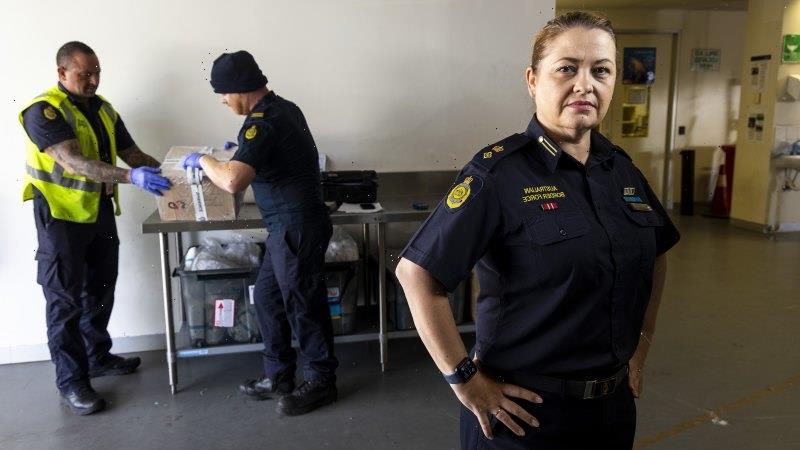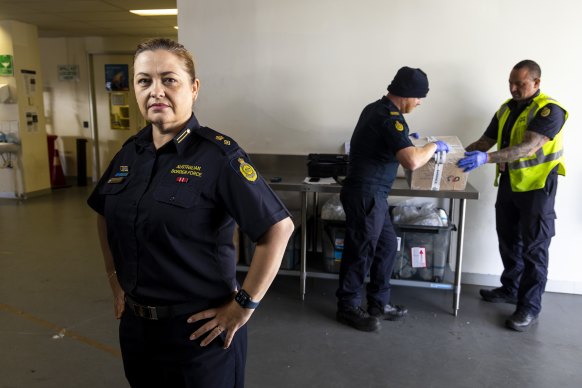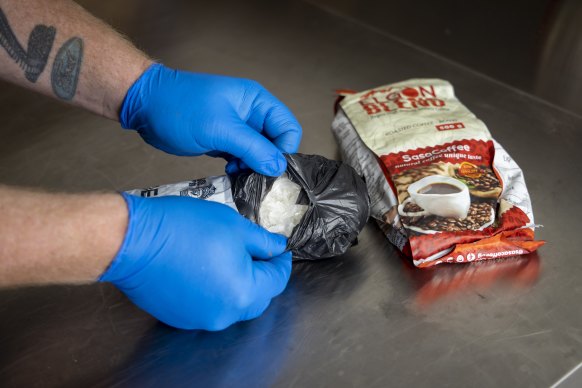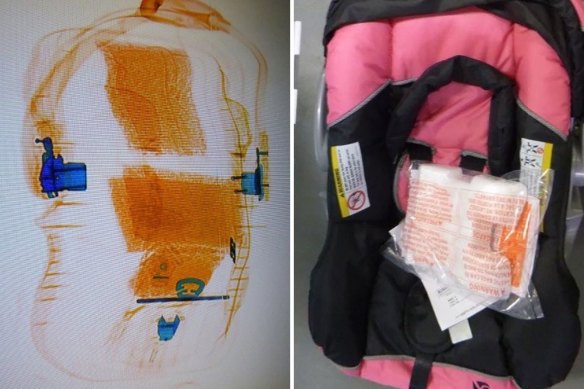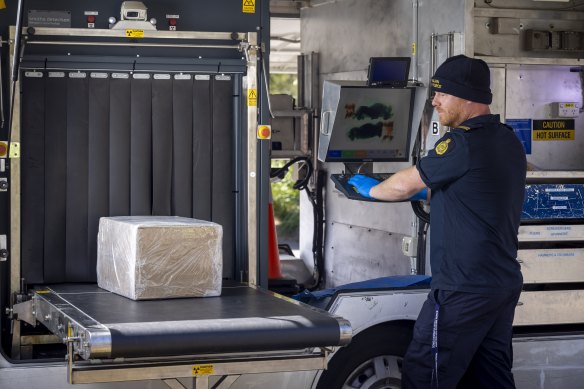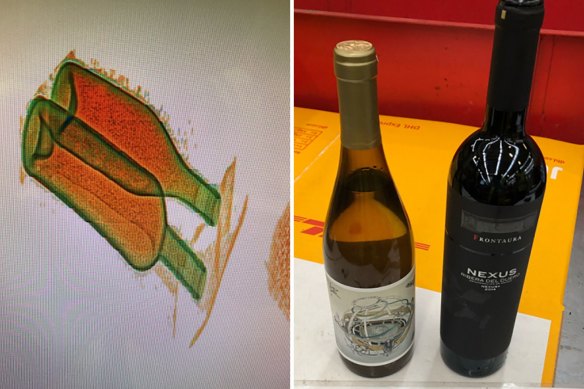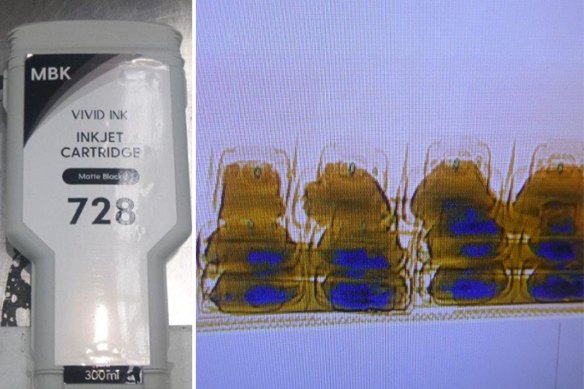Inside a shed in Melbourne’s outer suburbs, senior Australian Border Force officer Joel Scantlebury inspects a shipment of coffee beans that has arrived in Victoria by courier from a country in East Africa earlier that morning.
Hidden inside resealed coffee packets nestled in a sea of used clothes and shoes are three black plastic bags filled with white crystals. A chemical analysis of the substance, known as a NIK test, immediately returns a positive result for drugs.
Australian Border Force superintendent Tori Rosemond (left) and officers Joel Scantlebury and Steven Psiroukis at the agency’s headquarters at Melbourne Airport.Credit:Wayne Taylor
“You can see it’s slowly changing colour,” Scantlebury says of the liquid inside the vial of the NIK test he is holding in his hand.
Scantlebury has snapped the vial like a glow stick, spilling the solution into a bag, which contains crystal fragments from the parcel. The liquid has turned a vibrant cobalt blue, which indicates the presence of methamphetamine.
The parcel was sent to the agency’s facility near Melbourne Airport earlier that morning after it raised a series of red flags among the border security officers scanning newly arrived international cargo at the courier’s depot.
One of the key giveaways was a commercial invoice typed up on Google Docs where the name of the intended recipient was misspelled. The fact the commercial parcel included used clothing and footwear also aroused suspicion.
Senior Australian Border Force officer Joel Scantlebury examines a bag full of crystal meth hidden inside coffee packets. Credit:Wayne Taylor
The Age and The Sydney Morning Herald were given an exclusive tour of the facility on Thursday to see how Australian Border Force officials are tackling an unprecedented wave of illicit drugs making its way to Australian shores.
Officers have intercepted more than 10 tonnes of illicit substances bound for the black market since July, including record shipments of cocaine, meth, MDMA, heroin, and cannabis smuggled into Australia by air and sea.
ABF is now bracing for a year of “bumper” drug seizures and predicts the current spike in detections will extend beyond the usual summer and festival season bump to become a year-round feature.
“From what we’ve seen we are going to hit bumper amounts this year. We are on target to go above and beyond any detections that we’ve had,” Tori Rosemond, an ABF superintendent based in Melbourne, said.
X-ray of a baby carrier concealing several slabs of methamphetamine. The dark orange blocks indicate the location of the hidden drugs.Credit:Australian Border Force
“We’re not seeing it slow down. It peaked in the November, December, and January mark, and it’s still at those peaks.”
Rosemond said wastewater testing indicated drug consumption levels remained roughly similar, which meant law enforcement agencies were stopping most shipments at the border, or before they even made their way to Australia.
Most of the shipments were hidden inside household items being transported by air cargo such as pumps, lamps, baby carriers, and ink cartridges but Rosemond said some crooks were becoming more brazen in their attempts to smuggle drugs, sending them inside a parcel without attempting to disguise them.
Traffickers have previously soaked drugs into clothing, hidden narcotics in car parts, filled more than 1600 mustard bottles with liquid methamphetamine, smuggled 300 kilograms of MDMA inside bottles of 2016 Bordeaux wine, and replaced the contents of cereal boxes with cannabis.
Scantlebury scans a parcel suspected of containing narcotics. Credit:Wayne Taylor
But Rosemond said officers were so experienced in detecting narcotics they could guess what kind of dug was hidden inside a parcel by looking at an X-ray image of the cargo.
ABF uses tricolour X-ray machines similar to those found in airport terminals. Different materials show up in different colours when they are scanned; orange for organic substances, blue for metal, and green for mixed materials.
That means crooks attempting to smuggle drugs by wrapping them in aluminum foil or hiding them inside a car engine are destined to fail. An X-ray will show a dark block in a sea of blue, leading authorities to the haul.
The images also highlight changes in density and composition, which makes it easier for officers to detect if the liquid inside bottles has been replaced with another substance such as liquid MDMA or meth.
Wine bottles refilled with cocaine. The X-ray shows the different consistency of the drugs hidden inside the bottle. Credit:Australian Border Force
Rosemond said known narco-states often shipped the goods through a third country in a bid to avoid suspicion, but she said better co-operation with law enforcement agencies overseas had improved the chances of detection.
“I don’t think anything surprises us anymore, to be honest. We are open to finding it in anything and everything,” Rosemond said.
“People are confident they are going to get through, and they’re just not going to get it past.”
As Scantlebury places the coffee packets through the conveyer belt of the mobile X-ray machine the team has set up for us in the carpark the computer screen comes alive with a granulated orange image of the bags.
It only takes one glance at the screen to spot the hidden drugs. The black bag of crystal meth appears on the screen as a dark orange mass surrounded by a sea of lighter, less dense coffee beans.
Cocaine hidden inside ink cartridges. Credit:Australian Border Force
Scantlebury and fellow officer Steven Psiroukis repackage the coffee shipment and seal it using evidence tape. It will now be up to the Australian Federal Police to investigate where the parcel came from and its intended target in Australia.
For free and confidential advice about alcohol and other drug treatment services call the National Alcohol and Other Drug Hotline on 1800 250 015. Access free 24/7 drug and alcohol counselling online at www.counsellingonline.org
The Morning Edition newsletter is our guide to the day’s most important and interesting stories, analysis and insights. Sign up here.
Most Viewed in National
From our partners
Source: Read Full Article
